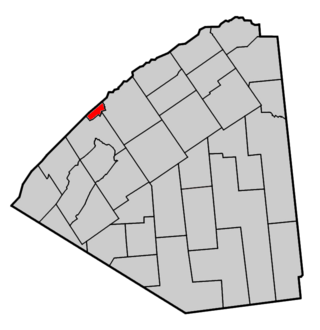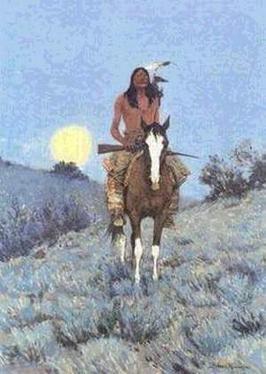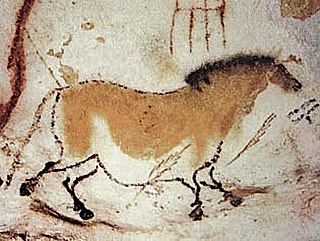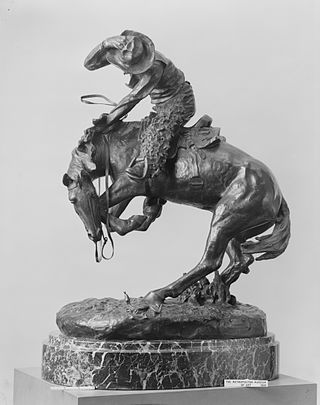
Ogdensburg is a city in St. Lawrence County, New York, United States. The population was 10,436 at the 2019 census. In the late 18th century, European-American settlers named the community after American land owner and developer Samuel Ogden. The city is at the northern border of New York at the mouth of the Oswegatchie River on the south bank of the St. Lawrence River. The only formally designated city in the county, it is located between Massena, New York to the east and Brockville, Ontario to the west.

Visual art of the United States or American art is visual art made in the United States or by U.S. artists. Before colonization, there were many flourishing traditions of Native American art, and where the Spanish colonized Spanish Colonial architecture and the accompanying styles in other media were quickly in place. Early colonial art on the East Coast initially relied on artists from Europe, with John White the earliest example. In the late 18th and early 19th centuries, artists primarily painted portraits, and some landscapes in a style based mainly on English painting. Furniture-makers imitating English styles and similar craftsmen were also established in the major cities, but in the English colonies, locally made pottery remained resolutely utilitarian until the 19th century, with fancy products imported.

Frederic Sackrider Remington was an American painter, illustrator, sculptor, and writer who specialized in the genre of Western American Art. His works are known for depicting the Western United States in the last quarter of the 19th century and featuring such images as cowboys, American Indians, and the US Cavalry.

The Amon Carter Museum of American Art (ACMAA) is located in Fort Worth, Texas, in the city's cultural district. The museum's permanent collection features paintings, photography, sculpture, and works on paper by leading artists working in the United States and its North American territories in the nineteenth and twentieth centuries. The greatest concentration of works falls into the period from the 1820s through the 1940s. Photographs, prints, and other works on paper produced up to the present day are also an area of strength in the museum's holdings.

Frederic Remington: The Truth of Other Days is a 1991 documentary film of American Western artist Frederic Remington made for the PBS series American Masters. It was produced and directed by Tom Neff and written by Neff and Louise LeQuire. Actor Gregory Peck narrated the film and Ned Beatty was the voice of Remington when reading his correspondence.

The Bronco Buster is a sculpture made of bronze copyrighted in 1895 by American artist Frederic Remington. It portrays a rugged cowboy character fighting to stay aboard a rearing, plunging bronco, with a stirrup swinging free, a quirt in one hand and a fistful of mane and reins in the other. It was the first and remains the most popular of all of Remington's sculptures.
Harold McCracken (1894–1983) was an American writer, Alaskan grizzly bear hunter, biplane stunt photographer, cinematographer, producer and museum director. He was a noted explorer, who led expeditions in the 1920s tracing the possibility of a long-ago land bridge between Siberia and Alaska.

Horses have appeared in works of art throughout history, frequently as depictions of the horse in battle. The horse appears less frequently in modern art, partly because the horse is no longer significant either as a mode of transportation or as an implement of war. Most modern representations are of famous contemporary horses, artwork associated with horse racing, or artwork associated with the historic cowboy or Native American tradition of the American West. In the United Kingdom, depictions of fox hunting and nostalgic rural scenes involving horses continue to be made.

The Mildred Lane Kemper Art Museum is an art museum located on the campus of Washington University in St. Louis, within the university's Sam Fox School of Design & Visual Arts. Founded in 1881 as the St. Louis School and Museum of Fine Arts, it was initially located in downtown St. Louis. It is the oldest art museum west of the Mississippi River. The Museum holds 19th-, 20th-, and 21st-century European and American paintings, sculptures, prints, installations, and photographs. The collection also includes some Egyptian and Greek antiquities and Old Master prints.

The Frederic Remington House is a historic house at 36 Oak Knoll Road in Ridgefield, Connecticut. A National Historic Landmark, it was the home of the painter and sculptor Frederic Remington (1861–1909) in the last few months of his life. Remington and his wife Eva designed the two-story gambrel-roofed, fieldstone-and-shingle house. He produced some of his finest work in the house including the sculpture The Stampede and the painting The Love Call. The house was declared a National Historic Landmark in 1965.

Rufus Fairchild Zogbaum was an American illustrator, journalist, and writer. He is primarily known as an illustrator for late 19th century news magazines. His works were regularly featured in Harper's Weekly magazine.

In art, a 'nocturne' its broader sense distinguishes paintings of a night scene, or night-piece, such as Rembrandt's The Night Watch, or the German Romantic Caspar David Friedrich's Two Men Contemplating the Moon of 1819.
Roman Bronze Works, now operated as Roman Bronze Studios, is a bronze foundry in New York City. Established in 1897 by Riccardo Bertelli, it was the first American foundry to specialize in the lost-wax casting method, and was the country's pre-eminent art foundry during the American Renaissance.
Alexander Nemerov is an American art historian. He is the Carl and Marilynn Thoma Provostial Professor in the Arts and Humanities at Stanford University. He specializes in American art dating from the nineteenth and twentieth centuries.

Deborah Remington was an American abstract painter. Her most notable work is characterized as Hard-edge painting abstraction.

The Sid Richardson Museum is located in historic Sundance Square in Fort Worth, Texas, and features permanent and special exhibitions of paintings by Frederic Remington and Charles M. Russell, as well as other late 19th and early 20th-century artists who worked in the American West. The works reflect both the artistic visions and realities of the American West, and were part of the personal collection of the late oilman and philanthropist, Sid Williams Richardson, (1891-1959). The paintings were acquired by him primarily through Newhouse Galleries in New York from 1942 until 1959. In addition to Remington and Russell, the collection includes works by Oscar E. Berninghaus, Charles F. Browne, Edwin W. Deming, William Gilbert Gaul, Peter Hurd, Frank Tenney Johnson, William R. Leigh, Peter Moran and Charles Schreyvogel.
The New Rochelle artist colony was a community of artists, actors, musicians, playwrights and writers who settled in the city of New Rochelle, New York, during the early twentieth century. By the 1920s, New Rochelle had more artists per capita than almost any city in the United States, and newspaper headlines were referring to the community as "Greenwich Village without the Greenwich."

The Rattlesnake is an equestrian sculpture by American artist Frederic Remington. The bronze sculpture was one of Remington's most popular, after The Broncho Buster, and it has been described as Remington's own favorite sculpture.

Fired On is a 1907 oil painting by Frederic Remington. It measures 68.8 cm × 101.6 cm and has been held by the Smithsonian American Art Museum since 1910.

The Advance-Guard, or The Military Sacrifice is an 1890 oil painting by Frederic Remington.

















